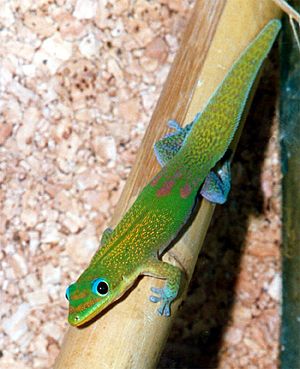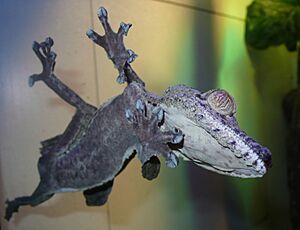Gecko facts for kids
Quick facts for kids GeckoTemporal range: around 110 million years ago to today
|
|
|---|---|
 |
|
| Gold dust day gecko | |
| Scientific classification |
|
| Kingdom: | Animalia |
| Phylum: | Chordata |
| Class: | Reptilia |
| Order: | Squamata |
| Infraorder: | Gekkota Cuvier, 1817 |
| Families | |
|
Pygopodidae |
|
Geckos are small to medium-sized lizards. They live in warm places all over the world. Most geckos are active at night. Some geckos, like the common house gecko, even live in people's houses. Many people like having them around because geckos eat lots of insects.
Unlike most lizards, geckos can make sounds. A gecko's voice might sound a bit like a bird or a frog. Most geckos lay eggs. But some kinds of geckos give birth to live young.
Geckos do not have eyelids. Instead, they have a clear skin layer over their eyes. They use their tongues to lick this layer clean. Like many lizards, geckos can grow back their tail if it breaks off. Their tail also helps them balance and store fat. Geckos also shed their skin, just like other reptiles. They can even replace their teeth every few months.
Geckos are amazing climbers. They can walk on trees, walls, windows, and even ceilings! They do this because their feet have special toe pads. These pads create a tiny bond with the surface they are walking on. This special force is called van der Waal's force. If you look closely with a microscope, you would see that each toe pad has thousands of tiny hair-like parts. These are called setae. Each seta then splits into even smaller ends called spatulae.
Contents
Gecko Families
There are six main families of geckos. These groups help scientists organize the many different kinds of geckos.
- Carphodactylidae
- Diplodactylidae
- Eublepharidae
- Gekkonidae
- Phyllodactylidae
- Sphaerodactylidae
Common Gecko Traits
Geckos come in many different colors and patterns. Some geckos can even change their color. They might look lighter at night. Some geckos can reproduce without a male. This means a female can have babies on her own. This helps geckos spread to new islands.
Geckos are cold-blooded, like other reptiles. This means their body temperature depends on their surroundings. They need to be warm enough to move, eat, and reproduce.
Shedding Skin
All geckos shed their skin regularly. The timing and way they shed can be different for each species. For example, Leopard geckos shed their skin about every two to four weeks. Having some moisture helps them shed. When a gecko starts to shed, it will often help the process by pulling off the loose skin. They sometimes even eat their old skin!
Amazing Climbing Ability
Geckos have special toe pads that help them stick to almost any surface. These pads have thousands of tiny hair-like structures called setae. These setae allow geckos to stick without using any liquids or sticky stuff.
These special feet are also self-cleaning. Any dirt that gets stuck usually falls off within a few steps.

Gecko Skin and Teeth
Gecko skin usually does not have scales like many other lizards. Instead, it is covered in very tiny hairs. This makes it hard for a gecko to get wet. Gecko skin can also help fight off bacteria.
Teeth Replacement
Geckos have about 100 teeth. They can replace each of their teeth every 3 to 4 months. This means they always have sharp, new teeth!
Interesting Gecko Facts
- There are over 1,196 different kinds of geckos.
- Geckos are some of the most colorful lizards in the world.
- Some geckos are named after the sounds they make. For example, the tokay gecko gets its name from the "to-KAY" sound the males make.
- It is harder for geckos to stick to Teflon than to many other surfaces.
- Every square millimeter of a gecko's footpad has about 14,000 hair-like setae. Each seta is very thin, about 5 micrometers wide. To compare, human hair is much thicker!
- A typical gecko weighing about 70 grams (2.5 ounces) could theoretically hold up a weight of 133 kilograms (293 pounds) with its feet! This shows how strong their grip is.
- If humans could copy how geckos stick, we could make amazing reusable sticky materials. But making these "synthetic setae" is very difficult.
Images for kids





